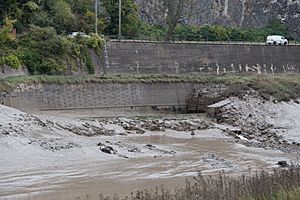Northern Stormwater Interceptor, Bristol facts for kids
The Northern Storm Water Interceptor (NSWI) is a huge underground tunnel. It works like a giant drain to stop floods in Bristol, England. This amazing tunnel helps keep the city safe from too much water.
Contents
Bristol's Giant Flood Tunnel
The Northern Storm Water Interceptor is a very important part of Bristol's flood defenses. It's a massive tunnel built deep underground. Its main job is to collect extra rainwater and stop areas of Bristol from flooding.
Why Was This Huge Tunnel Built?
Bristol has faced many floods over the years. A very bad flood happened in 1947. This event showed everyone that Bristol needed a better way to manage heavy rainfall. So, the idea for this giant tunnel was brought back to life.
Engineers had first thought of building a tunnel like this way back in the 1890s. But big events like World War I, the Great Depression, and World War II stopped the plans. After the 1947 flood, the city decided it was time to build it.
How Was the Tunnel Constructed?
Work on the Northern Storm Water Interceptor began in 1951. It took 11 years to build, finally finishing in 1962. The main tunnel is about 4 to 5 meters (13 to 16 feet) wide. That's as wide as a small room!
The tunnel starts at the River Frome in a place called Eastville. It then travels about 3 miles (5 kilometers) underground. It ends at Black Rocks Quarry in the Avon Gorge, where it releases water into the River Avon. Even though the main tunnel is 3 miles long, there are actually over 7 miles (11 kilometers) of tunnels in total!
Building the tunnel was a huge challenge. Workers had to blast through very hard rock. This included limestone, a type of rock called Dolimitic conglomerate, and Keuper marl. After blasting, the tunnel was lined with a thick layer of concrete. This concrete lining was about 375 millimeters (15 inches) thick. At its deepest point, the tunnel is about 90 meters (295 feet) underground. That's as deep as a 30-story building is tall! A company called A.E. Farr Limited built this incredible structure.
Clever Water Technology
During the tunnel's design, an engineer named Bernard Smission invented a special system. It's called the Energy Dissipating Vortex Drop Pipe System. This system helps control how water flows down into the tunnel. It makes sure the water doesn't cause damage as it drops from high places. Two of these clever systems were built along the tunnel. This technology has been so successful that it's now used in other big cities. You can find similar systems in Chicago, New York, and even Plymouth in England.
Remembering the Project
Near where the tunnel lets out water into the River Avon, there is a special plaque. It's just across the Portway road. This plaque was put there to remember the amazing work that went into building the tunnel.
The plaque says that the tunnel was built to stop floods in central, north, and east Bristol. It mentions that the project started in 1951 and includes 7.5 miles of tunnels. It also states that the main tunnel is 16 feet wide and over 3 miles long. It starts at the River Frome and ends at the River Avon. The plaque also notes that Dr. Charles Hill, a government minister, officially opened the works on April 4, 1962.
Engineers are still thinking about how to best manage flood risks in the Eastville area for the future.



